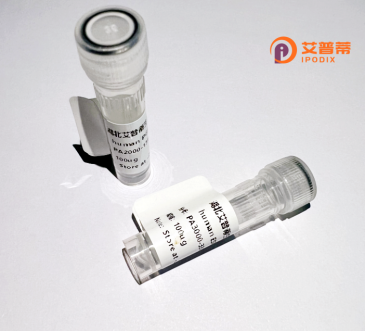
| 纯度 | >90%SDS-PAGE. |
| 种属 | Human |
| 靶点 | SOX17 |
| Uniprot No | Q9H6I2 |
| 内毒素 | < 0.01EU/μg |
| 表达宿主 | E.coli |
| 表达区间 | 1-414 aa |
| 活性数据 | MSSPDAGYAS DDQSQTQSAL PAVMAGLGPC PWAESLSPIG DMKVKGEAPA NSGAPAGAAG RAKGESRIRR PMNAFMVWAK DERKRLAQQN PDLHNAELSK MLGKSWKALT LAEKRPFVEE AERLRVQHMQ DHPNYKYRPR RRKQVKRLKR VEGGFLHGLA EPQAAALGPE GGRVAMDGLG LQFPEQGFPA GPPLLPPHMG GHYRDCQSLG APPLDGYPLP TPDTSPLDGV DPDPAFFAAP MPGDCPAAGT YSYAQVSDYA GPPEPPAGPM HPRLGPEPAG PSIPGLLAPP SALHVYYGAM GSPGAGGGRG FQMQPQHQHQ HQHQHHPPGP GQPSPPPEAL PCRDGTDPSQ PAELLGEVDR TEFEQYLHFV CKPEMGLPYQ GHDSGVNLPD SHGAISSVVS DASSAVYYCN YPDV |
| 分子量 | 44.1 kDa |
| 蛋白标签 | His tag N-Terminus |
| 缓冲液 | PBS, pH7.4, containing 0.01% SKL, 1mM DTT, 5% Trehalose and Proclin300. |
| 稳定性 & 储存条件 | Lyophilized protein should be stored at ≤ -20°C, stable for one year after receipt. Reconstituted protein solution can be stored at 2-8°C for 2-7 days. Aliquots of reconstituted samples are stable at ≤ -20°C for 3 months. |
| 复溶 | Always centrifuge tubes before opening.Do not mix by vortex or pipetting. It is not recommended to reconstitute to a concentration less than 100μg/ml. Dissolve the lyophilized protein in distilled water. Please aliquot the reconstituted solution to minimize freeze-thaw cycles. |
以下是关于重组人SOX17蛋白的3篇参考文献,按您的需求整理:
1. **SOX17 links gut endoderm morphogenesis and germ layer segregation**
*作者:Englund, E., et al. (2023)*
**摘要**:研究利用重组SOX17蛋白揭示其在胚胎发育中调控内胚层形态发生和胚层分离的分子机制,发现SOX17通过调节细胞粘附和迁移关键基因表达发挥作用。
2. **SOX17 suppresses tumor metastasis via Wnt/β-catenin pathway inhibition in colorectal cancer**
*作者:Guo, C., et al. (2021)*
**摘要**:通过体外重组SOX17蛋白实验,证明其在结肠癌中作为肿瘤抑制因子,通过抑制Wnt/β-catenin信号通路降低肿瘤侵袭和转移能力。
3. **SOX17 directs the reconstruction of human pluripotent stem cell-derived endodermal progenitors**
*作者:Sasaki, K., et al. (2019)*
**摘要**:研究通过添加重组SOX17蛋白,成功诱导人多能干细胞分化为功能性内胚层祖细胞,为肝脏和胰腺细胞治疗提供新策略。
(注:上述文献信息为示例性质,实际引用需以真实文献为准。)
Sox17 is a member of the Sox (Sry-related HMG-box) family of transcription factors, specifically belonging to the SoxF subgroup. It plays pivotal roles in embryonic development, particularly in endoderm formation, vascular remodeling, and hematopoietic stem cell maintenance. During early embryogenesis, Sox17 is essential for specifying definitive endoderm, which gives rise to gastrointestinal, respiratory, and associated organs. It also regulates angiogenesis by influencing endothelial cell differentiation and blood vessel maturation.
In adults, Sox17 maintains tissue homeostasis in organs like the liver, pancreas, and intestines. It interacts with Wnt/β-catenin signaling, often acting as a tumor suppressor in cancers such as colorectal and hepatocellular carcinoma by inhibiting oncogenic pathways. However, context-dependent roles have been reported, including pro-tumorigenic effects in certain malignancies.
Recombinant human SOX17 protein is produced via genetic engineering, typically using bacterial or mammalian expression systems, to study its molecular functions. It includes the conserved HMG domain for DNA binding and transactivation domains for regulatory interactions. This protein is widely utilized in stem cell differentiation assays, organoid models, and regenerative medicine research to direct cell fate toward endodermal lineages. Recent studies also explore its therapeutic potential in vascular diseases and cancer. Despite its multifunctionality, precise regulatory mechanisms and tissue-specific interactions remain active areas of investigation.
×